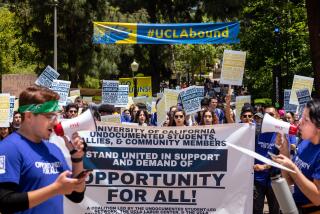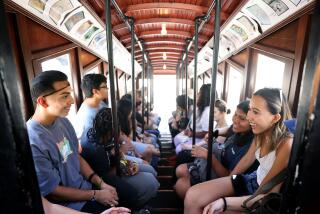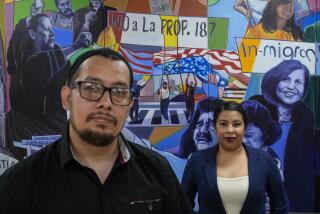Learning New Ways in Silence : Immigration: Some aliens flee one world of silence for another. Catholic Charities is teaching people seeking INS amnesty who cannot hear to read and to vocalize thoughts.
Jose Villanueva is at the head of the class, telling other students about voting for President of the United States.
“You keep learning sign language and you keep going to school and the President keeps on giving speeches, and then you can go vote,” he signs to the other students.
“Sure, you get nervous,” he says, making his knees tremble. “But you can work that out. You learn.”
The students are deaf immigrants applying for amnesty. They are living in a silent world here as much as in the nations of origin, and they came without the skills and tools that could help them learn a new system. Many in Sister Josie Gonzales’ classes at Holy Family Roman Catholic Cathedral in Orange have never been to any kind of school.
“They’re survivors,” says Gonzales, a teacher and the service coordinator for Catholic Charities’ Deaf Outreach program. “But they’re more than survivors. They came to this country not knowing the language and not being able to vocalize their thoughts. The spirit that they have, and the motivation, is not just to become citizens or residents. It is one to learn and to move ahead.”
Orange County Catholic Charities had received phone calls and inquiries about deaf immigrants who were trying to complete their requirements for amnesty, the immigration law that grants legal residency to aliens who can prove that they lived here since 1982. So last year, the organization began what is believed to be the first English-language and civics classes for deaf amnesty students in Orange and Los Angeles counties.
Amnesty applicants are required to attend 40 hours of English-language instruction and civics classes before they can apply for permanent legal residency. But no one had ever set up a class that would serve deaf applicants, Gonzales says.
Educators say the requirements have opened the world of education to many immigrants who often had little schooling in their own country. But in the case of Gonzales’ students, the effects have been even more dramatic.
Most of the nun’s students were the only deaf people in their families or in their rural communities, where there was no one trained to teach them.
Each of these students somehow made it through life, working to support themselves, sneaking across the border as illegal aliens, then also making a living in a foreign country, relying on a system of communication that each made up as he or she went along.
But now they are learning to express complicated thoughts by using universal symbols and sign language. They are discovering themselves and other deaf people, Gonzales says, because the classes have placed them in a network of services for deaf people, including a Sunday Mass.
Lupe Cardenas, 33, who works for a landscaping company in Garden Grove, says: “I had never heard of classes for the deaf until I applied for amnesty.”
The class began last year, and it has grown steadily. There are about 15 students who attend regularly, but Gonzales says she is sure that there are many more deaf immigrants who would probably take advantage of the classes if they knew about them.
One day last week, the class consisted of the round-faced Cardenas and Angel Olivarez of Santa Ana, who almost always wears a Lakers cap and who does boat maintenance and repairs. There was also Villanueva and his wife, Lina--both of them deaf--who often bring their year-old baby to class with them. Lina signs constantly, “chattering” on and on about how quickly her baby is learning to walk.
There is Juan Rodriguez of Santa Ana, a carpenter, and Margarito Flores of Santa Ana, who wears his long hair in a ponytail and is a laborer at one of the few farms remaining in Irvine.
Finally, there is Rodolfo Perez of Santa Ana, the oldest of the group, who is a janitor at the church and is proud of the business cards his employers had printed up for him.
They meet from 5 to 9 p.m. twice a week and spend part of their time sitting at school desks facing a blackboard as Gonzales or one of the nun’s students leads them in reading and writing lessons that include civics discussions.
During another part of the class, they stand in front of a large screen that depicts a typical town setting, including a supermarket, a car repair shop, a bank, a post office, a park, homes and a hospital. The students take turns describing scenes for each other, or asking each other how they would mail a letter, or what role a fire department plays in a city, so that they can practice their signing, Gonzales says.
“If the car is thirsty, you put in the gas,” Rodriguez signs to the class as he points to a gas station.
The exercise also evokes discussions about the nuances of living in America. For example, a picture of the police car led to a talk about seat belt requirements, drunk-driving laws and driver’s licenses.
Olivarez says he does not have a driver’s license.
“And you’ve been driving all these years?” Gonzales asks in astonishment. “We’re going to have to learn, so you can take the test. Come on, everybody, show him your licenses. Here in California you need one.
“If the policeman stops you, Angel, he’s going to ask, ‘Where’s your license?’ You’ll get a $75 ticket, and they could put you in jail,” she tells Olivarez, and one of the students shows him a brochure with a drawing of someone behind bars.
“I’ll go and pick up a book, and you and I will work together,” she says.
The rest of them, except Perez, have licenses and their own cars and have been driving for years.
The talk turns to sirens when they see an ambulance on the screen. “I keep my eye on that rear-view mirror, and I’m real careful and alert, and if I see that ambulance, I just pull over,” Cardenas says.
“I can hear it just a tiny bit,” Flores says. “When I see other people pulling over, then I pull over too.”
Someone brings up the SR-71 Blackbird spy plane’s speed records, and an argument begins over whether it flew across the United States from Los Angeles to Washington or around the world, as Cardenas insists. (It flew across the United States.)
“I’ll tell you what,” Gonzales signs to Cardenas. “I will find the newspaper stories, and Monday I’ll bring them in to show you.”
“But you know I can’t read,” he says quickly.
The nun assures him that she will tell him what the articles say.
“It was a great plane,” Cardenas continues about the Blackbird, which he refers to by touching his own black hair. “It was huge and it didn’t use much gas. It flew around the world.”
Most of these students say they could barely read or write--in English or in Spanish--when they began taking Gonzales’ class. Now they are working on writing the names of the months, their addresses and the words for common objects, such as money order or store.
“I’m understanding more and more now,” Cardenas says. “But my writing’s not what I want it to be yet.”
“Before, in Guadalajara, my reading was not very good,” Perez says. “Now it’s improving and improving. I don’t want to let it go now. I don’t want it to escape me.”
More to Read
Sign up for Essential California
The most important California stories and recommendations in your inbox every morning.
You may occasionally receive promotional content from the Los Angeles Times.










